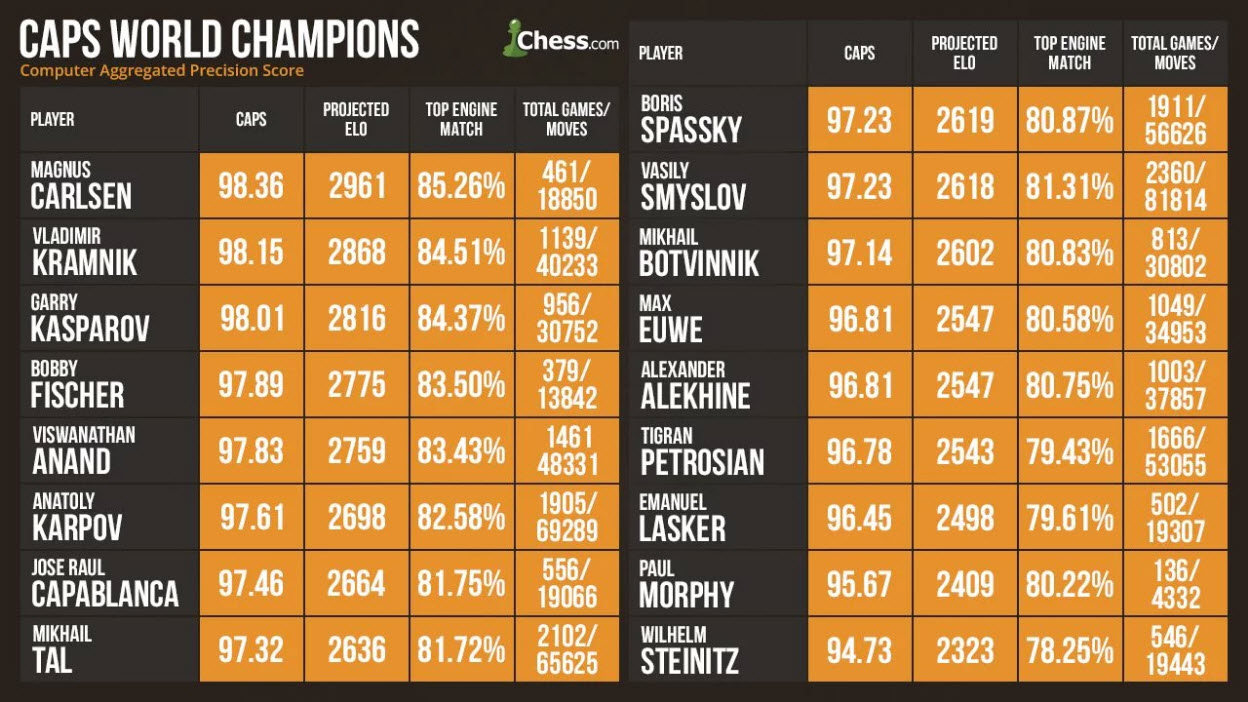Chess.com has recently developed a tool that evaluates the strength of play for any chess player, or the quality of moves of any chess game. They call it the Computer Aggregated Precision Score (or CAPS).
Essentially, what CAPS does is evaluate a player’s game (or set of games) and assess its moves for its accuracy against what the computers think are the best moves in each given position.
Now, since world champions of different eras have no way to prove their worth against each other, CAPS is a good way to evaluate and compare the quality of their games, and thus will give us a “rough estimate” of how well world champions will fare against each other should they face over the chessboard.
Indeed, Chess.com did just that.
Now, let’s find out how your favorite world champion fared using the CAPS system below:
What do you think? Do you agree with the CAPS system? Put your comments below.

Nice
I think CAPS doesnt take into consideration the complexity of the games. For example a player with a style like Tal or Shirov etc. tend to create chaos OTB. In these games is very difficult for both players to find best moves but these players think that the can find more best moves than the oppenent. That reduces the CAPS of both players but doesnt say anything about the strength of the players itself.
Very interesting table.
This was something I attempted in an effort to determine the relative strengths of some current and historical players some years ago. The problem with such quantitative methodologies IMO is that while they are fine as far as they go, they overlook the development of the game itself, and the fact that later players are standing on the shoulders of earlier players who were instrumental in building and developing the modern game and its theory. Morphy and Steinitz, in particular, swept all before them, both having been pioneers not just in their styles of chess, but in their genius in reorganising the way the game was played.
Steinitz exercised a domination over the chess world that has not been replicated since, apart from the possible exception of Fischer at his peak, and perhaps Kasparov. Morphy and Steinitz didn’t have the benefit of modern theory and technology, Indeed Steinitz laid the foundations for modern scientific chess paving the way for the more accurate play that became increasingly characteristic of later generations, especially the Soviet school and the current computer generation.
For these reasons, to rate Steinitz as being 2300+ is clearly wrong in real terms. You might as well compare the inventor of the wheel with modern engineers designing formula one racing cars.
In any case, this sort of quantitative analysis is fine as far as it goes but with obvious and severe limitations. It’s more instructive in charting the development of chess than in measuring relative strengths of players. I suspect that if all these players were contemporaries, there would probably not be a struck match between them.
The qualitative element of such studies are of course difficult to impossible by definition to measure, though of course some have attempted to do just that in trying to measure concepts like complexity.
Very profound and insightful answer… Also, after Googles’ AI swept the floor with Stockfish (playing in a style very different from “normal” machines, without any pre-programming or theory modules), we can also reconsider how accurate the tool is.
I agree. I think in terms of absolute strength the concept is sound. But the current tool is questionably accurate as automatically an player superior to the machine would rank below 100 too. I would like to see the ranking of AlphaZero with this tools as it demonstrated to be far superior to Stockfish.
if a player is ahead a pawn they will just trade off pieces instead off find best move in won game.